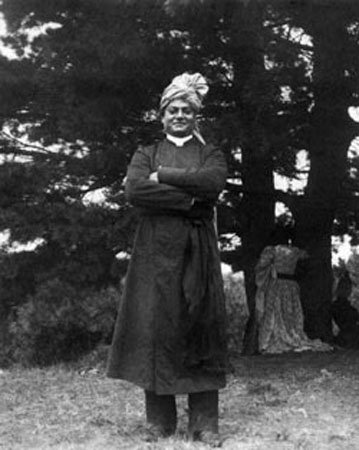Sri Ramakrishna
Contributed by Amrita M. Salm, Ph.D. and Prem Reid
Sri Ramakrishna (1853-1920), also called Ramakrishna Paramahamsa and the Master, was an Indian mystic who was devoted to God in the form of the Goddess Kali. He advocated the essential unity of religions and proclaimed that world religions are so many paths to reach the same goal. That goal is knowing one’s identity with God.
Photograph of Ramakrishna, taken on 10 December 1881 at the studio of "The Bengal Photographers" in Radhabazar, Calcutta (Kolkata).
Sri Ramakrishna was born in Kamarpukur, a small village located about sixty miles from Kolkata. His parents were poor, yet devout and virtuous; his father refused to lie. Ramakrishna, known as Gadadhar in his childhood, was loved by the villagers, was drawn to serving the traveling holy men, listening to their discourses, and was disinclined towards formal schooling and worldly affairs. Gadadhar was often immersed in spiritual moods. At the young age of six, he experienced his first ecstasy as he observed a flight of white cranes moving against a sky of black clouds. His tendency to enter into ecstasy only intensified with age. The death of his father, when Gadadhar was seven, contributed to this predisposition.
By 1855, Sri Ramakrishna was serving as the priest of the Kali Temple in Dakshineswar, close to the large city of Kolkata (then known as Calcutta). His spiritual fervor was so intense that at one time, the thought of not experiencing the living vision of the Divine Mother was so painful to him that he grabbed the ceremonial sword near Her image and considered ending his life. Then he was blessed with the vision of the Mother. He said, “I saw a limitless, infinite, effulgent Ocean of consciousness.” (The Gospel of Sri Ramakrishna, p.14) Sri Ramakrishna later taught his followers that if they would cry to the Lord with intensity as he had done, they would certainly see God.
Many thought that his God-intoxicated state was indicative of insanity, and the cure was marriage. At the time, he was twenty-three years old. A marriage, really a betrothal, as was customary in those days, was arranged. Actually, Sri Ramakrishna chose the bride, a child of five, from a neighboring village. After the marriage, he returned to Dakshineswar and again became absorbed in his intense spiritual life. Many spiritual teachers came to Dakshineswar and recognized Sri Ramakrishna as an incarnation of God and guided him into various traditions, including Vaishnavism, Tantra, Advaita Vedanta, and other paths. He also practiced both Islam and Christianity and later concluded, “As many faiths, so many paths.”
Ten years later, his bride, known as Saradamani (later referred to as the Holy Mother or Sri Sarada Devi) visited Dakshineswar to learn the truth of the rumors of his insanity. Instead, she found her husband was a gentle soul, and realized that he saw the Divine Mother in all women. He instructed her in various aspects of both spiritual and daily life. He later worshipped her as Shodashi, a form of Mother Kali, and both entered into samadhi.
Sri Ramakrishna was the embodiment of love and humility, a character trait only seen in incarnations of God. It appeared that he was in the guise of an unlettered village man, yet he spoke the highest wisdom and explained the most complex ideas of the scriptures with clarity through the use of simple examples and parables. Sri Ramakrishna lived in God and encouraged everyone to know that God realization is the primary goal of life.
He longed for young disciples ready to devote themselves completely to a life of purity and renunciation. Soon, a group of men gathered around him, served him, and began intense spiritual practices under his guidance. They longed for the realization of God. These young men later became the first monks of the Ramakrishna Order, which Ramakrishna himself created by giving them the sadhus’ robes and rosaries. He selected Narendranath Dutta, later known as Swami Vivekananda, as their leader. Later, they took formal monastic vows.
After many years of leading an intense God-intoxicated life and providing spiritual ministration, Sri Ramakrishna developed throat cancer in 1885. The future band of monks nursed him day and night for months before he left his body on August 16, 1886.
Suggested Readings
Swami Chetanananda. Sri Ramakrishna: A Divine Life in Pictures. Vedanta Society of St. Louis, 2015.
M. (Mahendranath Gupta), The Gospel of Sri Ramakrishna translated by Swami Nikhilananda. New York: Ramakrishna-Vivekananda Center,1984.
Saradananda, Swami. Sri Ramakrishna, The Great Master, translated by Swami Jagadananda. Chennai: Sri Ramakrishna Math, 1952.
Isherwood, Christopher. Ramakrishna and His Disciples. Los Angeles, Vedanta Press, 1965.
Rolland, Romain. The Life of Ramakrishna, translated by E.F. Malcolm-Smith. Kolkata: Advaita Ashrama, 1929.




